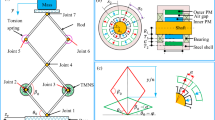Abstract
Different control schemes have been implemented over the last decade to suppress the overhead crane payload oscillation in rest-to-rest maneuvers. But in practice, the crane may not be at rest when a payload transition event is initiated. A generalized Zero Vibration with non-zero Initial Conditions (ZVIC) shaper is developed to generate optimal shaping commands for cranes with non-zero initial conditions. For any given set of initial states, this new shaper forces the system to minimize the residual oscillations. Compared to the conventional open-loop input shaping techniques, the proposed ZVIC can effectively reject crane vibrations induced by non-zero onset conditions. A comprehensive sensitivity analysis is performed for systems with different initial conditions and cable length settings. The results confirm that the proposed input shaping technique is insensitive to the initial states of the system.








Similar content being viewed by others
References
Manning R, Clement J, Kim D, Singhose W (2009) Dynamics and control of bridge cranes transporting distributed-mass payloads. ASME J Dyn Sys Meas Control 132(1):014505. https://doi.org/10.1115/1.4000657
Abdel-Rahman EM, Nayfeh AH, Masoud ZN (2003) Dynamics and control of cranes: a review. J Vib Control 9(7):863
Yu J, Lewis F, Huang T (1995) Nonlinear feedback control of a gantry crane. In: Proceedings of 1995 American control ccnference-ACC’95, vol 6 , vol 6, pp 4310–4315
Moustafa KA (1994) Feedback control of overhead cranes swing with variable rope length. In: Proceedings of 1994 American control conference-ACC’94, vol 1 (IEEE), vol 1, pp 691–695
Ngo QH, Hong KS (2010) Sliding-mode antisway control of an offshore container crane. IEEE/ASME Trans Mechatron 17(2):201
Park MS, Chwa D, Eom M (2014) Adaptive sliding-mode antisway control of uncertain overhead cranes with high-speed hoisting motion. IEEE Trans Fuzzy Syst 22(5):1262
Mahfouf M, Kee C, Abbod MF, Linkens DA (2000) Fuzzy logic-based anti-sway control design for overhead cranes. Neural Comput Appl 9(1):38
Zhang M, Ma X, Rong X, Tian X, Li Y (2016) Adaptive tracking control for double-pendulum overhead cranes subject to tracking error limitation, parametric uncertainties and external disturbances. Mech Syst Signal Process 76:15
Smoczek J, Szpytko J (2017) Soft-constrained predictive control for an overhead crane. J KONES 24:291–298
Schindele D, Aschemann H (2011) Fast nonlinear MPC for an overhead travelling crane. IFAC Proc Vol 44(1):7963
Giacomelli M, Faroni M, Gorni D, Marini A, Simoni L, Visioli A (2018) MPC-PID control of operator-in-the-loop overhead cranes: a practical approach. In 2018 7th International conference on systems and control (ICSC) (IEEE), pp 321–326
Ahmad M, Ismail R.R, Ramli M, Ghani N.A, Hambali N (2009) Investigations of feed-forward techniques for anti-sway control of 3-D gantry crane system. In 2009 IEEE symposium on industrial electronics and applications, vol 1 (IEEE), vol 1, pp 265–270
Garrido S, Abderrahim M, Gimenez A, Diez R, Balaguer C (2008) Anti-swinging input shaping control of an automatic construction crane. IEEE Trans Autom Sci Eng 5(3):549
Gniadek M (2015) Usage of input shaping for crane load oscillation reduction. In: 2015 20th International conference on methods and models in automation and robotics (MMAR) (IEEE), pp 278–282
Singh T (2004) Jerk limited input shapers. J Dy Sys Meas Control 126(1):215
Singer NC, Seering WP (1990) Preshaping command inputs to reduce system vibration. ASME J Dyn Sys Meas Control 112(1):76–82. https://doi.org/10.1115/1.2894142
Kim D, Singhose W (2010) Performance studies of human operators driving double-pendulum bridge cranes. Control Eng Pract 18(6):567
Vaughan J, Yano A, Singhose W (2008) Comparison of robust input shapers. J Sound Vib 315(4–5):797
Starr GP (1985) Swing-free transport of suspended objects with a path-controlled robot manipulator. ASME J Dyn Sys Meas Control 107(1):97–100. https://doi.org/10.1115/1.3140715
Alhazza K.A, Masoud Z.N (2010) A novel wave-form command-shaping control with application on overhead cranes In ASME 2010 dynamic systems and control conference , pp 331–336
Alhazza KA (2013) Experimental validation on a continuous modulated wave-form command shaping applied on damped systems. In: Catbas F, Pakzad S, Racic V, Pavic A, Reynolds P (eds) Topics in dynamics of civil structures, vol 4. Conference proceedings of the society for experimental mechanics series. Springer, New York, NY. https://doi.org/10.1007/978-1-4614-6555-3_48
Alghanim K, Mohammed A, Andani MT (2019) An input shaping control scheme with application on overhead cranes. Int J Nonlinear Sci Numer Simul 20(5):561
Mohammed A, Alghanim K, Andani MT (2019) An optimized non-linear input shaper for payload oscillation suppression of crane point-to-point maneuvers. Int J Dyn Control 7(2):567
Alhazza KA, Hasan AM, Alghanim KA, Masoud ZN (2014) An iterative learning control technique for point-to-point maneuvers applied on an overhead crane. Shock Vib 2014:261509. https://doi.org/10.1155/2014/261509
Chang P.H, Park J, Park J.Y Commandless input shaping technique. In: Proceedings of the 2001 American control conference.(Cat. No. 01CH37148)
Newman D, Vaughan J (2017) Reduction of transient payload swing in a harmonically excited boom crane by shaping luff commands. In: ASME 2017 dynamic systems and control conference
Newman D, Vaughan J (2017) Command shaping of a boom crane subject to nonzero initial conditions. In: 2017 IEEE conference on control technology and applications (CCTA), pp 1189–1194
Huey JR, Sorensen KL, Singhose WE (2008) Useful applications of closed-loop signal shaping controllers. Control Eng Pract 16(7):836
Staehlin U, Singh T (2013) Design of closed-loop input shaping controllers. In: Proceedings of the 2003 American control conference, 2003., vol 6 (IEEE, 2003), vol 6, pp 5167–5172
Park JY, Chang PH (2004) Vibration control of a telescopic handler using time delay control and commandless input shaping technique. Control Eng Pract 12(6):769
Veciana JM, Cardona S, Català P (2013) Minimizing residual vibrations for non-zero initial states: application to an emergency stop of a crane. Int J Precis Eng Manuf 14(11):1901
Dhanda A, Vaughan J, Singhose W (2016) Vibration reduction using near time-optimal commands for systems with nonzero initial conditions. J Dyn Syst Meas Control 138(4):041006. https://doi.org/10.1115/1.4032064
Author information
Authors and Affiliations
Corresponding author
Rights and permissions
About this article
Cite this article
Mohammed, A., Alghanim, K. & Andani, M.T. A robust input shaper for trajectory control of overhead cranes with non-zero initial states. Int. J. Dynam. Control 9, 230–239 (2021). https://doi.org/10.1007/s40435-020-00631-0
Received:
Revised:
Accepted:
Published:
Issue Date:
DOI: https://doi.org/10.1007/s40435-020-00631-0




